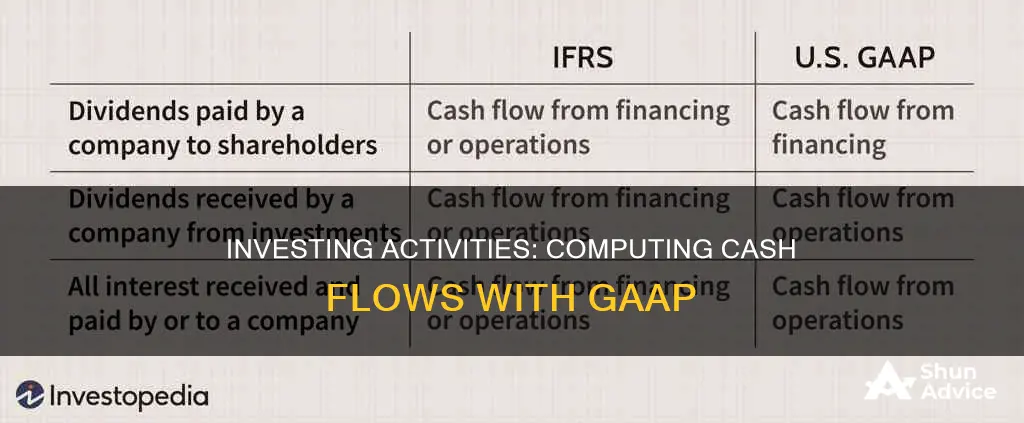
Cash flow statements are one of the three fundamental financial statements that provide crucial financial data to inform a company's decision-making. They detail the cash that entered and left a business during a reporting period. One of the sections of the cash flow statement is cash flow from investing activities, which details the cash flow related to the buying and selling of long-term assets like property, facilities, and equipment. This section is important as it shows how a company is allocating cash for the long term. To calculate cash flow from investing activities, you need to add the purchases or sales of property and equipment, other businesses, and marketable securities.
| Characteristics | Values |
|---|---|
| Cash flow from investing activities details | Cash flows related to the buying and selling of long-term assets |
| Types of investing activities | Purchase of fixed assets |
| Purchase of investments such as stocks or securities | |
| Sale of fixed assets | |
| Sale of investment securities | |
| Collection of loans and insurance proceeds | |
| Calculating cash flow from investing activities | CFI = Purchase/Sale of Property and Equipment + Purchase/Sale of Other Businesses + Purchase/Sale of Marketable Securities |
What You'll Learn

Cash flow from operating activities
This section includes cash received from the sale of goods and services, salary and wage payments, and payments to suppliers for inventory or production needs. It is calculated using either the direct or indirect method, both of which are accepted under Generally Accepted Accounting Principles (GAAP).
The direct method involves subtracting all cash disbursements from operations from the total cash collections. This approach is more time-consuming as it requires accounting for every transaction during the reporting period, but it provides a straightforward calculation.
On the other hand, the indirect method starts with net income from the income statement and makes adjustments to reverse the impact of accruals during the period, including depreciation and amortization. While faster and more closely linked to the balance sheet, this method still results in the same number as the direct method.
The cash flow from operating activities is an essential metric for understanding a company's financial health and sustainability. It provides insights into the company's ability to generate cash from its regular operations, helping stakeholders and business leaders make informed decisions about the company's value and overall health.
Recording Cash Investments: A Step-by-Step Guide for Beginners
You may want to see also

Cash flow from investing activities
These investments can be made to generate income or they may be long-term investments in the health and performance of the company. For example, a company may invest in fixed assets such as property, plant, and equipment to grow the business. This would show as a negative cash flow from investing activities in the short term, but it may help generate cash flow in the longer term.
The cash flow statement is one of the three financial reports that a company generates in an accounting period. It bridges the gap between the income statement and the balance sheet by showing how cash is generated or spent on operating, investing, and financing activities.
The formula for calculating cash flow from investing activities is:
CFI = Purchase/Sale of Property and Equipment + Purchase/Sale of Other Businesses + Purchase/Sale of Marketable Securities
These items can be found in a cash flow statement or by comparing non-current assets on the balance sheet over two periods.
It's important to note that negative cash flow from investing activities does not always indicate poor financial health. It often signifies that the company is investing in assets, research, or other long-term development activities that are crucial for the company's health and continued operations.
Cash is Not King: Exploring Investment Alternatives
You may want to see also

Cash flow from financing activities
Financing activities include transactions involving debt, equity, and dividends. Examples include:
- Receiving cash from issuing stock or spending cash to repurchase shares
- Receiving cash from issuing debt or paying down debt
- Paying cash dividends to shareholders
- Proceeds received from employees exercising stock options
- Receiving cash from issuing hybrid securities, such as convertible debt
A positive number in the cash flow from financing activities indicates that cash has come into the company, increasing its asset levels. On the other hand, a negative number indicates that the company has paid out capital, such as retiring or paying off long-term debt or making dividend payments.
The formula for calculating cash flow from financing activities is:
Financing Cash Flow = Cash Inflows from Issuing Equity or Debt - (Dividends Paid + Repurchase of Debt and Equity)
This formula can be used to determine if a business is on a sound financial footing. A company that frequently takes on new debt or equity for cash might show positive cash flow from financing activities, but it could indicate that the company is not generating enough earnings.
The cash flow from financing activities section is important for investors as it provides insight into a company's financial strength and how well its capital structure is managed. It also helps investors understand how often and how much a company raises capital and the source of that capital. If the company is consistently issuing new stock or taking on debt, it may be an unattractive investment opportunity.
Is Buying Furniture an Investment or Cash Flow Expense?
You may want to see also

Calculating free cash flow
Free cash flow is the money left over after a company has paid its operating expenses and capital expenditures. It is the cash available for a company to use as it pleases, such as paying dividends to shareholders or investing in growth. It is an important metric for assessing a company's financial health and its ability to generate cash.
There are several methods to calculate free cash flow, but the most common approach uses operating cash flow and capital expenditures, which are readily found in financial statements. The formula for this method is:
> Free Cash Flow = Operating Cash Flow – Capital Expenditures
Alternatively, free cash flow can be calculated using the following formula:
> Free Cash Flow = Net Income + Non-Cash Expenses – Change in Working Capital – Capital Expenditure
In this formula, non-cash expenses include depreciation, amortization, and taxes. Working capital is the difference between a company's current assets and liabilities.
Free cash flow can also be calculated using sales revenue and net operating profits. The sales revenue method focuses on the revenue generated by a company and subtracts the associated costs, including taxes and operating costs. The net operating profit method is similar but uses operating income instead of sales revenue.
Free cash flow is a useful tool for investors and companies alike. Investors can use it to assess a company's financial health, profitability, and dividend potential. Companies can use it for cash management and to make decisions about new products, debt, and business opportunities.
Journaling a Large Cash Investment: A Step-by-Step Guide
You may want to see also

Negative cash flow
A negative cash flow from investing activities can be a warning sign that a company's management is inefficient at using its assets to generate revenue. However, it could also be a positive sign that the company is investing in its long-term growth.
A negative cash flow from investing activities means that the company is spending more cash on its investing activities than it is generating. This can be due to a variety of reasons, such as purchasing physical assets, investing in securities, or the sale of securities or assets. It is important to note that negative cash flow from investing activities is not always a bad sign, as it can indicate that the company is investing in its future growth.
To calculate cash flow from investing activities, you need to add the purchases or sales of property, equipment, other businesses, and marketable securities. This can be found on the cash flow statement or by comparing non-current assets on the balance sheet over two periods.
For example, a company spent $30 billion on capital expenditures, $5 billion on investments, and $1 billion on acquisitions. They also realised a positive inflow of $3 billion from the sale of investments. To calculate the cash flow from investing activities, we add these amounts together, resulting in an annual figure of -$33 billion.
While a negative cash flow from investing activities can be concerning, it is important to review the entire cash flow statement to understand the context. A company might have a negative cash flow from investing activities because it is investing in long-term assets that will aid its future growth.
Understanding Cash Flow: Investing Activities Analysis
You may want to see also
Frequently asked questions
Cash flow from investing activities (CFI) is a section of a company's cash flow statement that details the cash flow related to the buying and selling of long-term assets like property, facilities, and equipment. It also includes investments in securities, or the sale of securities or assets.
Investing activities include the purchase of fixed assets, investments such as stocks or securities, and the sale of fixed assets or investment securities.
To calculate cash flow from investing activities, you need to add the purchases or sales of property and equipment, other businesses, and marketable securities. These items are listed in a cash flow statement and can also be identified by comparing non-current assets on the balance sheet over two periods.
Cash flow from investing activities is important because it indicates how a company is allocating cash for the long term. For example, a company may invest in fixed assets like property, plant, and equipment to grow the business. While this may result in negative cash flow from investing activities in the short term, it could lead to positive cash flow and significant growth in the long term.







